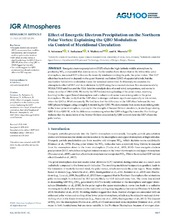| dc.contributor.author | Salminen, A | |
| dc.contributor.author | Asikainen, T. | |
| dc.contributor.author | Maliniemi, Ville Aleksi | |
| dc.contributor.author | Mursula, K. | |
| dc.date.accessioned | 2020-06-19T09:38:32Z | |
| dc.date.available | 2020-06-19T09:38:32Z | |
| dc.date.issued | 2019 | |
| dc.Published | Salminen, Asikainen T, Maliniemi VA, Mursula K. Effect of Energetic Electron Precipitation on the Northern Polar Vortex: Explaining the QBO Modulation via Control of Meridional Circulation. Journal of Geophysical Research (JGR): Space Physics. 2019;124(11):5807-5821 | eng |
| dc.identifier.issn | 2169-9402 | en_US |
| dc.identifier.issn | 2169-9380 | en_US |
| dc.identifier.uri | https://hdl.handle.net/1956/22765 | |
| dc.description.abstract | Energetic electron precipitation (EEP) affects the high‐latitude middle atmosphere by producing NOX compounds that destroy ozone. Earlier studies have shown that in the wintertime polar stratosphere, increased EEP enhances the westerly wind surrounding the pole, the polar vortex. This EEP effect has been found to depend on the quasi‐biennial oscillation (QBO) of equatorial winds, but the mechanism behind this modulation has so far remained unresolved. In this study we examine the atmospheric effect of EEP and its modulation by QBO using the corrected electron flux measurements by NOAA/POES satellites and the ERA‐Interim reanalysis data of zonal wind, temperature, and ozone in winter months of 1980–2016. We verify the EEP‐related strengthening of the polar vortex, warming (cooling) in the upper (lower) stratosphere and a reduction of ozone mass mixing ratio in the polar stratosphere. We also verify that the EEP effect is stronger and more significant especially in late winter, when the QBO at 30 hPa is easterly. We find here that the difference in the EEP effect between the two QBO phases is largest using a roughly 6‐month lag for QBO. We demonstrate that ozone mass mixing ratio in the lower polar stratosphere, a proxy for the strength of Brewer‐Dobson circulation, is also larger during QBO‐E than QBO‐W, with the difference maximizing when the QBO is lagged by 6 months. Our findings indicate that the modulation of the Brewer‐Dobson circulation by QBO controls how the EEP affects the polar vortex. | en_US |
| dc.language.iso | eng | eng |
| dc.publisher | AGU | en_US |
| dc.title | Effect of Energetic Electron Precipitation on the Northern Polar Vortex: Explaining the QBO Modulation via Control of Meridional Circulation | en_US |
| dc.type | Peer reviewed | |
| dc.type | Journal article | |
| dc.date.updated | 2019-11-22T09:47:24Z | |
| dc.description.version | acceptedVersion | en_US |
| dc.rights.holder | Copyright 2019. American Geophysical Union. All Rights Reserved. | en_US |
| dc.identifier.doi | https://doi.org/10.1029/2018jd029296 | |
| dc.identifier.cristin | 1711100 | |
| dc.source.journal | Journal of Geophysical Research (JGR): Space Physics | |
